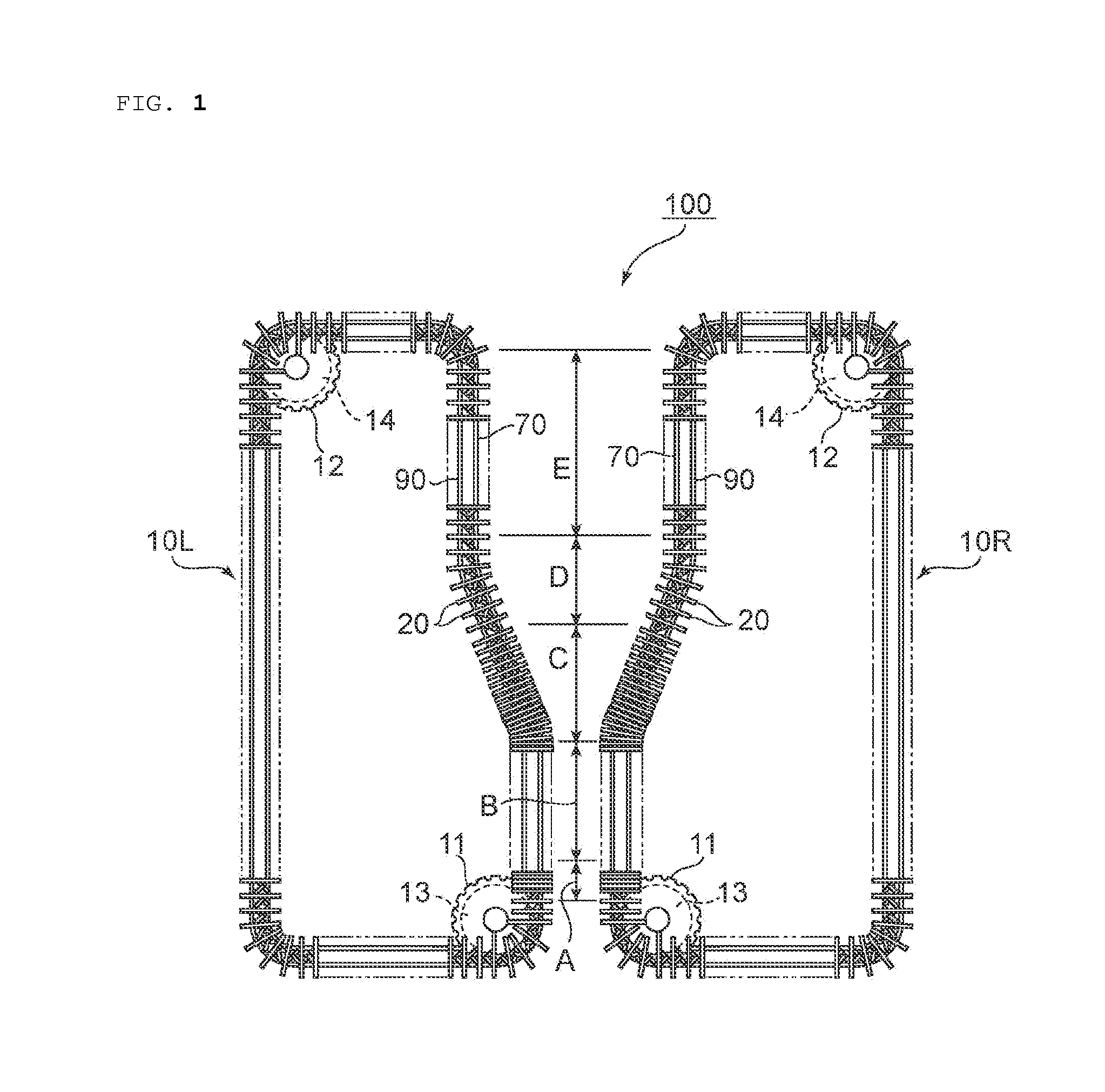Method for producing phase-difference film and method for producing circularly polarizing plate
a production method and retardation film technology, applied in the direction of polarizing elements, instruments, other domestic objects, etc., can solve the problems of remarkable problems, uneven optical characteristics and/or mechanical characteristics of retardation films to be obtained, etc., to achieve small changes in retardation, excellent axial accuracy, and high production efficiency
- Summary
- Abstract
- Description
- Claims
- Application Information
AI Technical Summary
Benefits of technology
Problems solved by technology
Method used
Image
Examples
example 1
Production of Polycarbonate Resin Film
[0085]Polymerization was performed with a batch polymerization apparatus formed of two vertical reactors each including a stirring blade and a reflux condenser controlled to 100° C. 9,9-[4-(2-Hydroxyethoxy)phenyl]fluorene (BHEPF), isosorbide (ISB), diethylene glycol (DEG), diphenyl carbonate (DPC), and magnesium acetate tetrahydrate were loaded at a molar ratio “BHEPF / ISB / DEG / DPC / magnesium acetate” of 0.348 / 0.490 / 0.162 / 1.005 / 1.00×10−5. After a first reactor had been sufficiently purged with nitrogen (oxygen concentration: 0.0005 vol % to 0.001 vol %), the inside of the reactor was warmed with a heating medium, and when a temperature in the reactor reached 100° C., stirring was started. 40 Minutes after the start of the temperature increase, the internal temperature was caused to reach 220° C. and the reactor was controlled so as to hold the temperature, and at the same time, a pressure reduction was started. 90 Minutes after the temperature had ...
example 2
[0093]A polycarbonate resin film (thickness: 155 μm, width: 765 mm) obtained in the same manner as in Example 1 except that its thickness was different from that of Example 1 was used and obliquely stretched according to such clip pitch profile as illustrated in FIG. 6 to provide a retardation film. Specifically, the increase of the clip pitch of the right clips was started simultaneously with the entry of the film into the first oblique stretching zone C1, and in the first oblique stretching zone C1, the clip pitch was increased from 125 mm to 177.5 mm. A clip pitch change ratio was 1.42. In the first oblique stretching zone C1, the reduction of the clip pitch of the left clips was started. In the first oblique stretching zone C1, the clip pitch was reduced from 125 mm to 90 mm. A clip pitch change ratio was 0.72. Further, the increase of the clip pitch of the left clips was started simultaneously with the entry of the film into the second oblique stretching zone C2, and in the sec...
example 3
[0095]A retardation film (thickness: 63 μm) was obtained in the same manner as in Example 2 except that: a polycarbonate resin film (thickness: 165 μm, width: 765 mm) obtained in the same manner as in Example 1 except that its thickness was different from that of Example 1 was used; and longitudinal shrinkage-lateral stretching (lateral stretching ratio: 1.05 times) was performed after the oblique stretching (including the lateral stretching) and before the MD shrinkage treatment. It should be noted that a shrinkage ratio in a longitudinal direction was the sum of the shrinkage ratio of the longitudinal shrinkage of the longitudinal shrinkage-lateral stretching and the shrinkage ratio of the MD shrinkage treatment, and the shrinkage ratio was 7.0% as in Example 2. Both ends of the resultant retardation film were trimmed so that its width became 800 mm, and the film was subjected to the same evaluations as those of Example 1. The results are shown in Table 1.
PUM
| Property | Measurement | Unit |
|---|---|---|
| shrinkage ratio | aaaaa | aaaaa |
| angle | aaaaa | aaaaa |
| temperature | aaaaa | aaaaa |
Abstract
Description
Claims
Application Information
 Login to View More
Login to View More - R&D
- Intellectual Property
- Life Sciences
- Materials
- Tech Scout
- Unparalleled Data Quality
- Higher Quality Content
- 60% Fewer Hallucinations
Browse by: Latest US Patents, China's latest patents, Technical Efficacy Thesaurus, Application Domain, Technology Topic, Popular Technical Reports.
© 2025 PatSnap. All rights reserved.Legal|Privacy policy|Modern Slavery Act Transparency Statement|Sitemap|About US| Contact US: help@patsnap.com



